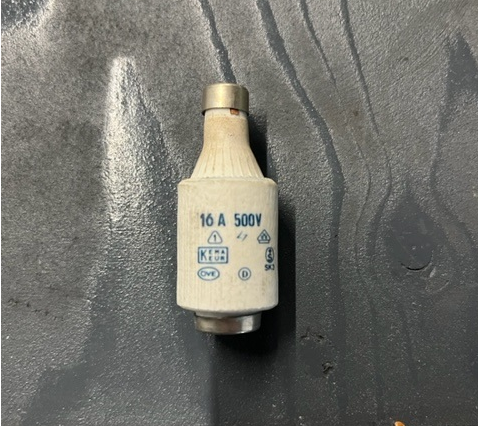This arrangement was at the intake position of a vehicle workshop with no upstream isolator. Change fuses at your peril!
Any one familiar with set-up, I remember something similar in my daughter's ancient apartment in Romania.


See this link. The fuses are still available! en.wikipedia.org/.../IEC_60269
That is a blast from the past. East Germany was very similar too at one time. when a building supply was 3 phase at about 30 amps a phase from overheads on an H -pole . A steady hand is certainly needed when changing the bottle tops in the older style cabinets.
The local approach was to wear gloves of some kind - probably for flash injury as much as shock.
The fuses however are very good - with the right holder the diameter of the snout means you cannot put an oversize fuse in, and there were indicator models also available, with a spring and a little cap that dropped off if the fuse wire had broken showing which one to change..
The bullet shape means the non-rupturing breaking capacity of some of these is massive - from memory for incomer ones, figures like 50kA AC and 8KA DC, and means that questions of 16kA or 32KA PSSC would be utterly moot.
Actually in the east except perhaps in central Berlin there was no chance of that sort of current anyway, managing more than 200V on full load in some places would have been good !!
Mike
An old Siemens board - we had loads of them inside German & Italian machine tools control cabinets. The fuses are screw-in types which have a coloured coded 'dot' or cap in the front which denoted it's rating, and which also popped out when the fuse blew. Still quite a few about I'll bet. We had them inside Morando vertical boring machines and Erfurt steel bar cropping machines.
"coded 'dot' or cap in the front which denoted it's rating, and which also popped out when the fuse blew. "
Ah yes - those are the indicator models I was trying to describe, Some of the screw tops had a glas window so you could see that without opening anything.
Once you get used to them, they are quite a good system.
Mike
We had those bottle fuses in an ancient 60 amp 450 volt DC power supply at a factory I worked at every time there was a short on the DC output 2 of the 3 input fuses would blow we soon ran out of spares and resorted to using heavy fusewire wrapped around the bottles. It seems that in Eastern Europe poor voltage regulation is a big problem. One you tube video showed the mains in an apartment in Ukrain drop from 205 down to 150 volts when his water heater came on. Hopefully after the war things like that will get sorted
About 6 years ago I did a consumer unit change in a large property in the posh part of a small town in Cheshire. TT with re-wirable fuses, exposed live parts in the consumer unit , which was metal and seven foot off the floor above a toilet with no RCD protection. In passing the customer complained about the long time it took to cook Christmas lunch. When finishing at about 18:00, with the customer wanting to get rid of me so they could cook their dinner, I did my final test on the Zs on the cooker circuit and noticed the voltage was 190V. It was the same on other circuits. The Ze and voltage had been OK when tested earlier. I advised the customer to complain to the emergency number on their bill. I spoke to them some weeks later and they told me their supplier said it was OK and they would be taking no further action! I have not spoken to them since so have not idea if it was ever fixed. Normally I would have phoned the supplier my self but the customer had Alzheimers and his visiting daughter was deperalty trying to get rid of me as the day had been very stressful for him and he wanted his dinner
It is not just overseas that has low voltage problems.
We're about to take you to the IET registration website. Don't worry though, you'll be sent straight back to the community after completing the registration.
Continue to the IET registration site